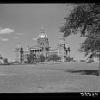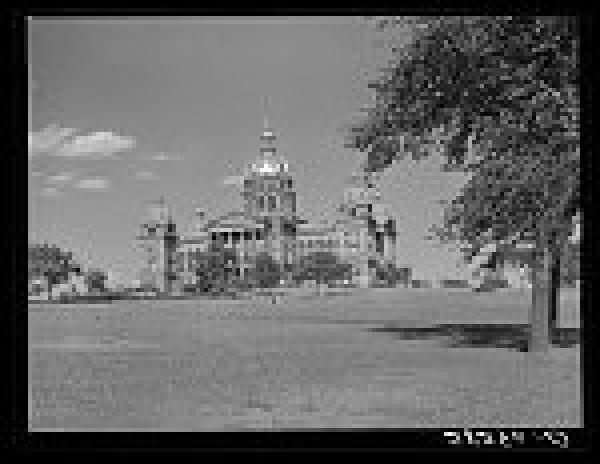Iowa’s State Capitol and the Functions of Iowa’s State Government
| Grade | 7th Grade, 8th Grade | Class | U.S. Government | Length of Lesson | 2 Class periods |
| Lesson Title | Iowa’s State Capitol and the Functions of Iowa’s State Government |
| Unit Title | Iowa’s Government System |
| Unit Compelling Question | How does Iowa’s government function? How is it different from the Federal government? |
| Historical Context: When Iowa entered the Union as the 29th state, early leaders drew on experience and set up a government much like those in states they have moved from. The authority for both Federal and state government stems from the will of the people who govern through their elected leaders. They adopted a state constitution that defines the authority and limits of the state government and the rights of its citizens. Like earlier states, Iowa set up three branches of government. Like the Federal government, each branch of the state government has some authority to oversee the other two branches. The state legislature, composed of a House of Representatives and the Senate, makes laws. The executive branch, headed by the governor and a few elected officials, manages the budget and state agencies, appoints judges, and can reject (veto) laws if he or she does not approve of them. The legislature can override (re-enact) a veto if two-thirds of the members of both houses approve. The judicial branch determines guilt or innocence in criminal cases and resolves disputes between citizens, between citizens and the state, and between different parts of government. This kind of divided authority is often called a system of checks and balances. Iowa also created 99 county governments that handle local issues for citizens. In each county, one city is designated as the county seat. A court house provides offices for elected county officials. Local officials collect taxes, have law enforcement officers, issue licenses, maintain local roads, and many other necessary functions. There are also school districts that run public schools. Cities and towns have their own government with officials elected by the people. Des Moines is the capital of Iowa. The Iowa Capitol (NOTE: The spelling of the building ends in t-o-l) is where the legislature meets and the governor and top state officials have their offices. The Iowa Supreme Court Building is across the road south of the Capitol. The legislature usually meets the first four or five months of every year. Members of the House of Representatives are elected every two years. Senators and governors serve four-year terms. Justices of the Iowa Supreme Court serve for life if they are approved by voters every six years. Like the Federal constitution, the Iowa constitution can be amended (changed) when new circumstances require it. If the legislature proposes an amendment twice (and there must be a general election between the two approvals) and if a majority of voters approve it, an amendment becomes part of the basic law of the land. The first constitution of Iowa lasted from 1846 to 1857. In that year, the voters of the state approved a new constitution, with a structure fundamentally the same as the first but with a few significant changes. Iowans are proud of the stability and openness of our state government. Our state motto is proudly displayed on the state flag: "Our liberties we prize and our rights we will maintain." |
|
| Lesson Supporting Question | |
| Lesson Overview | We will be reviewing Iowa’s system of Government and outlining the key roles and functions within the state government during day one. Students will also be working with groups on day one to create a worksheet/poster comparing the Iowa State Government to the U.S. Federal Government. On day two we will then take a virtual tour of the Iowa Capitol building and fill out a corresponding worksheet based on the content covered on day one and the tour guides information.
|
| Primary Sources Used |
|
| Resources Needed | https://docs.google.com/presentation/d/1EmzVG2eWQeewqR15JgUxn6X_IRXbaEbwUtU_cQNzu5g/edit?usp=sharing https://www.legis.iowa.gov/resources/tourCapitol/pictorial/virtual |
| Standard | |
| Lesson Target | Students will be able to differentiate between the three branches of state government and discuss their varying roles.;Students will be able to compare and contrast Iowa’s Government with the Federal Government.;Students will be able to understand the history of Iowa’s Capitol building.;Students will be able to identify where in the Capitol important decisions are made from each branch. |
| Lesson Themes | Forms of Government, Political System, Services |
|
| Formative Assessment (How will you use the formative assessments to monitor and inform instruction?) |
I will be able to use the information on each groups diagram/chart on day one comparing state and federal governments to see their level of understanding., I will be able to use student worksheets from day two to evaluate what students deemed the most important processes and events in order to assess understanding thus far. |
| Summative Assessment (How does the lesson connect to planned summative assessment(s)?) |
| Author | Taylor Boozell | Created | Last Edited | ||||
| Reviewer: Chad Christopher, History Education, University of Northern Iowa | |||||||
| Lesson Plan Development Notes: Teaching Methods, University of Northern Iowa, Spring 2019 | |||||||


